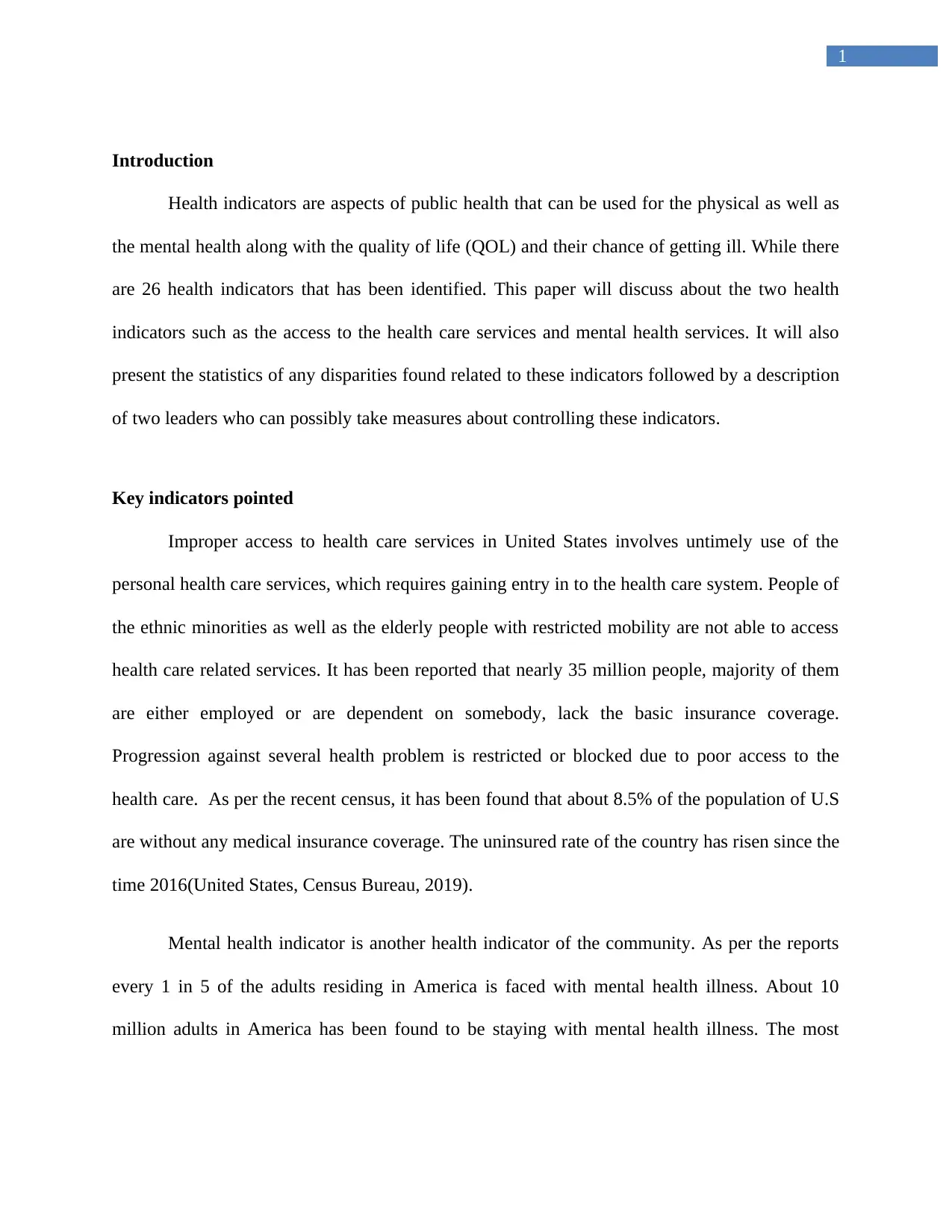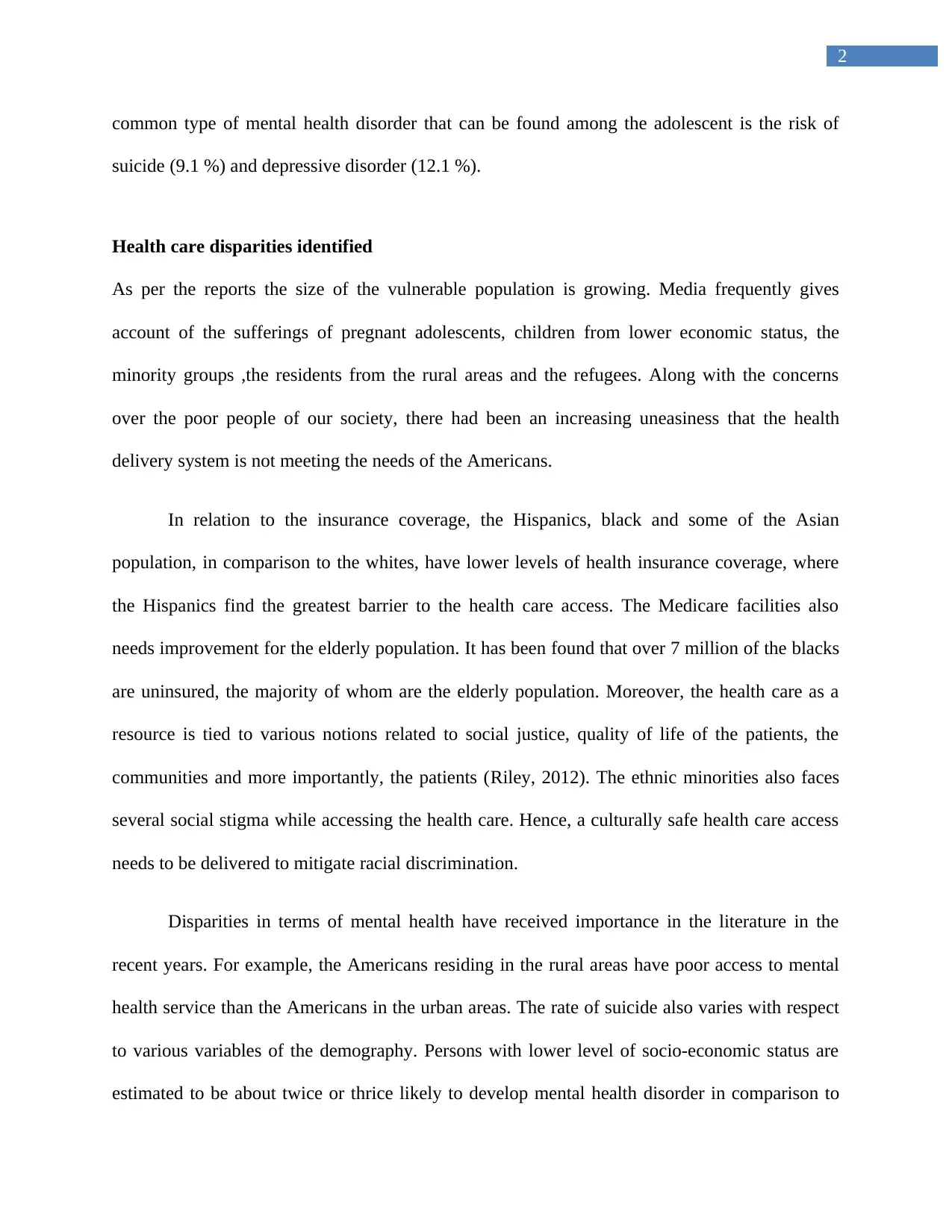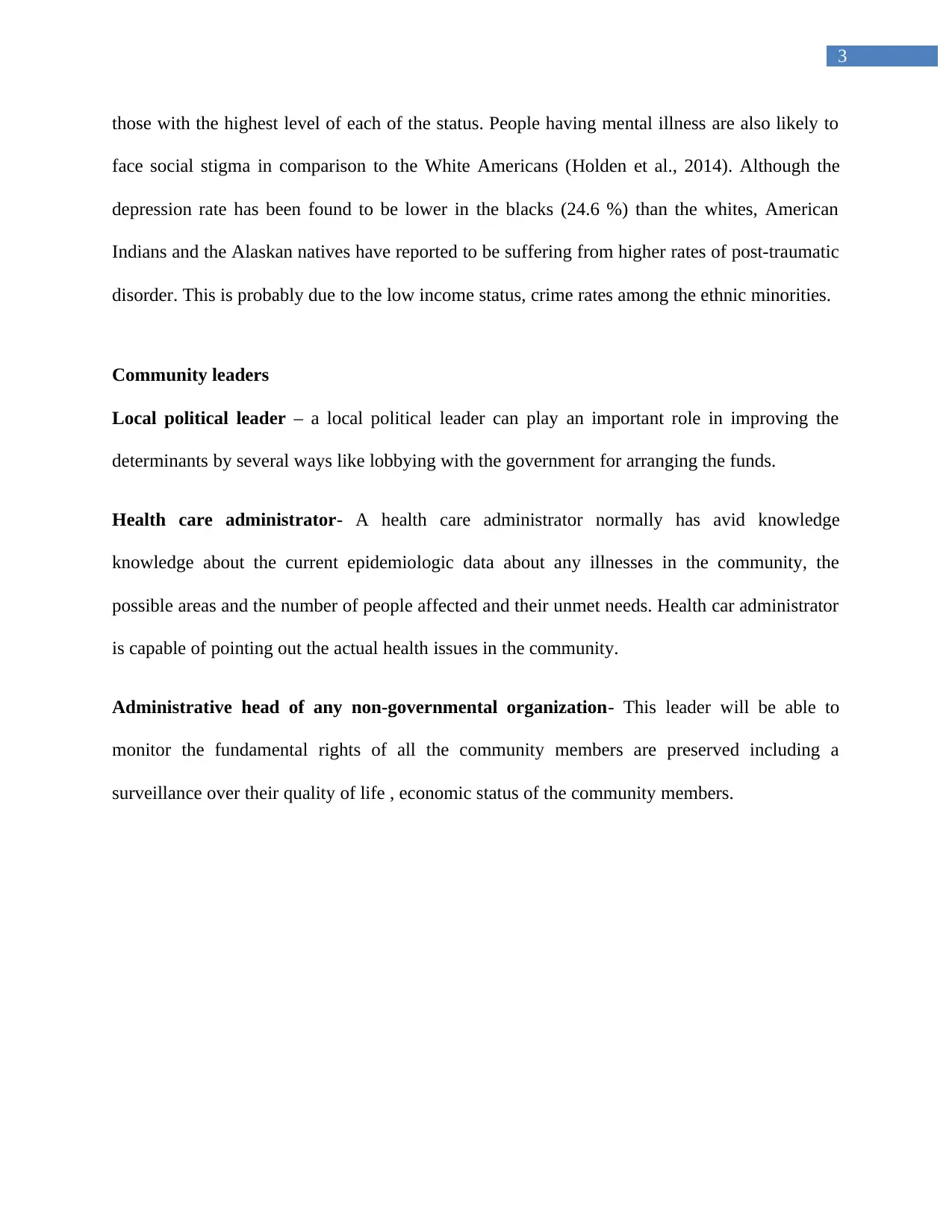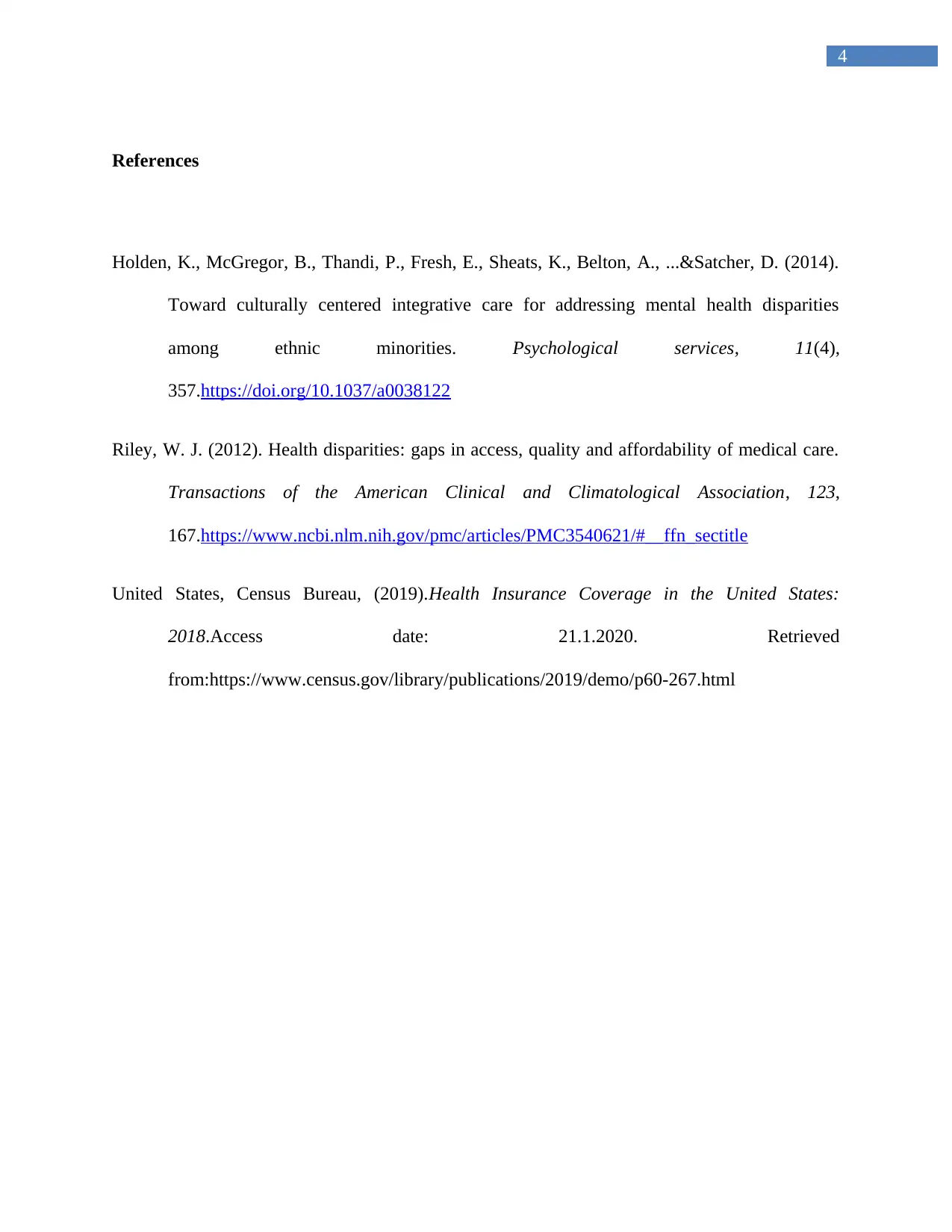Nursing Assignment on Health Indicators
VerifiedAdded on 2022/08/24
|5
|1002
|22
Assignment
AI Summary
Contribute Materials
Your contribution can guide someone’s learning journey. Share your
documents today.

NURSING ASSIGNMENT
Name of the Student
Name of the university
Author’s note
Name of the Student
Name of the university
Author’s note
Secure Best Marks with AI Grader
Need help grading? Try our AI Grader for instant feedback on your assignments.

1
Introduction
Health indicators are aspects of public health that can be used for the physical as well as
the mental health along with the quality of life (QOL) and their chance of getting ill. While there
are 26 health indicators that has been identified. This paper will discuss about the two health
indicators such as the access to the health care services and mental health services. It will also
present the statistics of any disparities found related to these indicators followed by a description
of two leaders who can possibly take measures about controlling these indicators.
Key indicators pointed
Improper access to health care services in United States involves untimely use of the
personal health care services, which requires gaining entry in to the health care system. People of
the ethnic minorities as well as the elderly people with restricted mobility are not able to access
health care related services. It has been reported that nearly 35 million people, majority of them
are either employed or are dependent on somebody, lack the basic insurance coverage.
Progression against several health problem is restricted or blocked due to poor access to the
health care. As per the recent census, it has been found that about 8.5% of the population of U.S
are without any medical insurance coverage. The uninsured rate of the country has risen since the
time 2016(United States, Census Bureau, 2019).
Mental health indicator is another health indicator of the community. As per the reports
every 1 in 5 of the adults residing in America is faced with mental health illness. About 10
million adults in America has been found to be staying with mental health illness. The most
Introduction
Health indicators are aspects of public health that can be used for the physical as well as
the mental health along with the quality of life (QOL) and their chance of getting ill. While there
are 26 health indicators that has been identified. This paper will discuss about the two health
indicators such as the access to the health care services and mental health services. It will also
present the statistics of any disparities found related to these indicators followed by a description
of two leaders who can possibly take measures about controlling these indicators.
Key indicators pointed
Improper access to health care services in United States involves untimely use of the
personal health care services, which requires gaining entry in to the health care system. People of
the ethnic minorities as well as the elderly people with restricted mobility are not able to access
health care related services. It has been reported that nearly 35 million people, majority of them
are either employed or are dependent on somebody, lack the basic insurance coverage.
Progression against several health problem is restricted or blocked due to poor access to the
health care. As per the recent census, it has been found that about 8.5% of the population of U.S
are without any medical insurance coverage. The uninsured rate of the country has risen since the
time 2016(United States, Census Bureau, 2019).
Mental health indicator is another health indicator of the community. As per the reports
every 1 in 5 of the adults residing in America is faced with mental health illness. About 10
million adults in America has been found to be staying with mental health illness. The most

2
common type of mental health disorder that can be found among the adolescent is the risk of
suicide (9.1 %) and depressive disorder (12.1 %).
Health care disparities identified
As per the reports the size of the vulnerable population is growing. Media frequently gives
account of the sufferings of pregnant adolescents, children from lower economic status, the
minority groups ,the residents from the rural areas and the refugees. Along with the concerns
over the poor people of our society, there had been an increasing uneasiness that the health
delivery system is not meeting the needs of the Americans.
In relation to the insurance coverage, the Hispanics, black and some of the Asian
population, in comparison to the whites, have lower levels of health insurance coverage, where
the Hispanics find the greatest barrier to the health care access. The Medicare facilities also
needs improvement for the elderly population. It has been found that over 7 million of the blacks
are uninsured, the majority of whom are the elderly population. Moreover, the health care as a
resource is tied to various notions related to social justice, quality of life of the patients, the
communities and more importantly, the patients (Riley, 2012). The ethnic minorities also faces
several social stigma while accessing the health care. Hence, a culturally safe health care access
needs to be delivered to mitigate racial discrimination.
Disparities in terms of mental health have received importance in the literature in the
recent years. For example, the Americans residing in the rural areas have poor access to mental
health service than the Americans in the urban areas. The rate of suicide also varies with respect
to various variables of the demography. Persons with lower level of socio-economic status are
estimated to be about twice or thrice likely to develop mental health disorder in comparison to
common type of mental health disorder that can be found among the adolescent is the risk of
suicide (9.1 %) and depressive disorder (12.1 %).
Health care disparities identified
As per the reports the size of the vulnerable population is growing. Media frequently gives
account of the sufferings of pregnant adolescents, children from lower economic status, the
minority groups ,the residents from the rural areas and the refugees. Along with the concerns
over the poor people of our society, there had been an increasing uneasiness that the health
delivery system is not meeting the needs of the Americans.
In relation to the insurance coverage, the Hispanics, black and some of the Asian
population, in comparison to the whites, have lower levels of health insurance coverage, where
the Hispanics find the greatest barrier to the health care access. The Medicare facilities also
needs improvement for the elderly population. It has been found that over 7 million of the blacks
are uninsured, the majority of whom are the elderly population. Moreover, the health care as a
resource is tied to various notions related to social justice, quality of life of the patients, the
communities and more importantly, the patients (Riley, 2012). The ethnic minorities also faces
several social stigma while accessing the health care. Hence, a culturally safe health care access
needs to be delivered to mitigate racial discrimination.
Disparities in terms of mental health have received importance in the literature in the
recent years. For example, the Americans residing in the rural areas have poor access to mental
health service than the Americans in the urban areas. The rate of suicide also varies with respect
to various variables of the demography. Persons with lower level of socio-economic status are
estimated to be about twice or thrice likely to develop mental health disorder in comparison to

3
those with the highest level of each of the status. People having mental illness are also likely to
face social stigma in comparison to the White Americans (Holden et al., 2014). Although the
depression rate has been found to be lower in the blacks (24.6 %) than the whites, American
Indians and the Alaskan natives have reported to be suffering from higher rates of post-traumatic
disorder. This is probably due to the low income status, crime rates among the ethnic minorities.
Community leaders
Local political leader – a local political leader can play an important role in improving the
determinants by several ways like lobbying with the government for arranging the funds.
Health care administrator- A health care administrator normally has avid knowledge
knowledge about the current epidemiologic data about any illnesses in the community, the
possible areas and the number of people affected and their unmet needs. Health car administrator
is capable of pointing out the actual health issues in the community.
Administrative head of any non-governmental organization- This leader will be able to
monitor the fundamental rights of all the community members are preserved including a
surveillance over their quality of life , economic status of the community members.
those with the highest level of each of the status. People having mental illness are also likely to
face social stigma in comparison to the White Americans (Holden et al., 2014). Although the
depression rate has been found to be lower in the blacks (24.6 %) than the whites, American
Indians and the Alaskan natives have reported to be suffering from higher rates of post-traumatic
disorder. This is probably due to the low income status, crime rates among the ethnic minorities.
Community leaders
Local political leader – a local political leader can play an important role in improving the
determinants by several ways like lobbying with the government for arranging the funds.
Health care administrator- A health care administrator normally has avid knowledge
knowledge about the current epidemiologic data about any illnesses in the community, the
possible areas and the number of people affected and their unmet needs. Health car administrator
is capable of pointing out the actual health issues in the community.
Administrative head of any non-governmental organization- This leader will be able to
monitor the fundamental rights of all the community members are preserved including a
surveillance over their quality of life , economic status of the community members.
Secure Best Marks with AI Grader
Need help grading? Try our AI Grader for instant feedback on your assignments.

4
References
Holden, K., McGregor, B., Thandi, P., Fresh, E., Sheats, K., Belton, A., ...&Satcher, D. (2014).
Toward culturally centered integrative care for addressing mental health disparities
among ethnic minorities. Psychological services, 11(4),
357.https://doi.org/10.1037/a0038122
Riley, W. J. (2012). Health disparities: gaps in access, quality and affordability of medical care.
Transactions of the American Clinical and Climatological Association, 123,
167.https://www.ncbi.nlm.nih.gov/pmc/articles/PMC3540621/#__ffn_sectitle
United States, Census Bureau, (2019).Health Insurance Coverage in the United States:
2018.Access date: 21.1.2020. Retrieved
from:https://www.census.gov/library/publications/2019/demo/p60-267.html
References
Holden, K., McGregor, B., Thandi, P., Fresh, E., Sheats, K., Belton, A., ...&Satcher, D. (2014).
Toward culturally centered integrative care for addressing mental health disparities
among ethnic minorities. Psychological services, 11(4),
357.https://doi.org/10.1037/a0038122
Riley, W. J. (2012). Health disparities: gaps in access, quality and affordability of medical care.
Transactions of the American Clinical and Climatological Association, 123,
167.https://www.ncbi.nlm.nih.gov/pmc/articles/PMC3540621/#__ffn_sectitle
United States, Census Bureau, (2019).Health Insurance Coverage in the United States:
2018.Access date: 21.1.2020. Retrieved
from:https://www.census.gov/library/publications/2019/demo/p60-267.html
1 out of 5
Related Documents
Your All-in-One AI-Powered Toolkit for Academic Success.
+13062052269
info@desklib.com
Available 24*7 on WhatsApp / Email
![[object Object]](/_next/static/media/star-bottom.7253800d.svg)
Unlock your academic potential
© 2024 | Zucol Services PVT LTD | All rights reserved.





